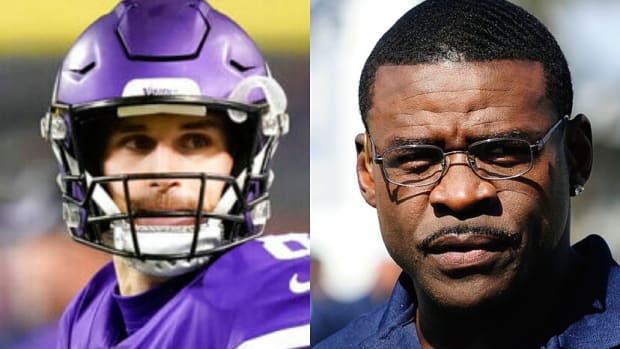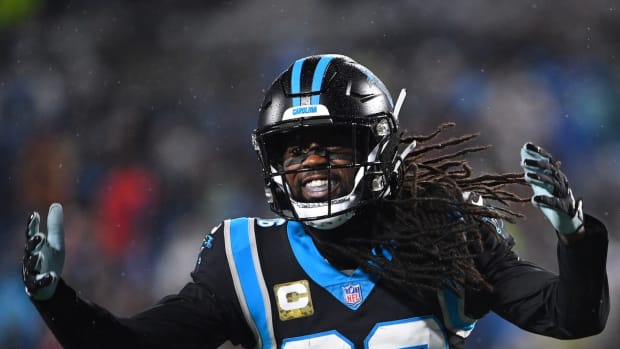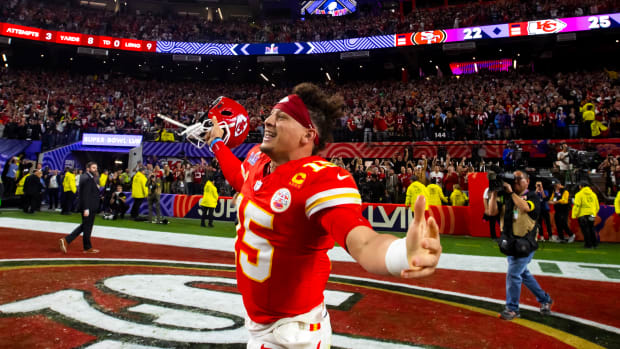What Is Le’Veon Bell Worth?
The side of the Steelers locker room where Maurkice Pouncey sat was mostly quiet. The Steelers were getting ready for a mid-week practice, preparation for their upcoming Monday night game in Tampa. Antonio Brown had drawn a big media crowd on the opposite end of the room, explaining his frustrations over the team’s winless start, acknowledging the distraction he’d caused by sending a tweet suggesting he be traded. A gospel song, “The Storm is Over Now,” played in the background.
To a much smaller audience, Pouncey made clear he was moving on, too. The veteran center nodded in the direction of James Conner, the second-year running back who was getting ready nearby.
“Conner has done a great job,” Pouncey said, “and I wouldn’t mind having him at running back the whole entire year.”
Pouncey was among the locker-room cornerstones who thought Le’Veon Bell would show up before Week 1, spoke out publicly when he did not, and now is intent on not letting Bell’s absence interfere with the season. Bell has still not reported for work nor signed his $14.5 million franchise tender, and ESPN reported over the weekend that the Steelers are now listening to trade offers, perhaps weary of the looming question of when Bell will show up.
Many around the league see that as a difficult trade to get done, given that Bell does not have a contract past this year and a team would be giving up a draft pick for, at this point, less than a full season of games. “I don’t see a team giving up a second-round pick, because you still have to pay the player,” one team decision-maker says, “and why would the Steelers give him away for less than that?” The suitor would have to be a really good team, on the cusp of what could be a really good season, one that would be even better with an explosive running back. A team like … well, the Steelers.
Bell’s holdout is highly unusual. With the deadline for negotiations with tagged players coming and going in July, league rules prevent Bell from negotiating the kind of long-term extension he seeks until after the season. He is losing $855,000 for each game he misses, while the Steelers are trying to win without one-third of the offensive triumvirate that should be potent enough to contend for another title. At the heart of the issue is an existential question in today’s NFL: What level of commitment should a team make to a running back who has proven himself as a transcendent talent? Or, in short: What is Le’Veon Bell worth?
The Steelers seem to have a knack for responding to, even thriving among drama. “Not in a sense that we look for it,” guard Ramon Foster says. “In the sense that we have been through it before.”
In a topsy-turvy Week 3 in the NFL, perhaps it should have come as no surprise that the previously winless Steelers handled the previously unbeaten Buccaneers, 30-27. Ben Roethlisberger passed for 353 yards, and the Steelers defense had four takeaways. As much as the win calms the waters, it’s hard not to watch the Steelers offense and wonder what it would look like with Bell.
Bell holds the franchise record for scrimmage yards in a season, with 2,215 in 2014, his second year in the league. During his five seasons in Pittsburgh, he’s second in receptions (312) and receiving yards (2,660) for the franchise, behind only Antonio Brown in both categories. He is the prototype back for the modern NFL, a bruiser with the receiving skills to split out wide regularly—an enduring dilemma for opposing defenses.
The Steelers were willing to reward Bell for that special ability, negotiating toward a long-term deal after they tagged him last year and this year—it just wasn’t to the level at which Bell believes he is worth. NFL Network reported that the Steelers’ final offer to Bell this summer was for five years, $70 million, with $10 million fully guaranteed (the Steelers have a long-standing policy of not offering guarantees in veteran deals beyond the first year) and a chance to earn $45 million over the first three years. (Bell’s agent, Adisa Bakari, did not respond to a request for comment, and Steelers GM Kevin Colbert was not made available for comment by the team.)
The stage was set for a split, but most believed it would come after this season. Bakari told SiriusXM in mid-July that Bell would join the team after training camp and before Week 1, as he did last season, unless “something exceptional” occurred. The best guess is that the “something exceptional” was the four-year, $60 million extension Todd Gurley signed with the Rams about a week later. Gurley’s contract included nearly $22 million fully guaranteed at signing and a total of $45 million in guarantees locked in by March 2020.
Gurley’s contract reset a running back market that had sagged since Adrian Peterson and Chris Johnson signed extensions in 2011, due to a combination of factors such as a devaluation of the position in a pass-happy NFL, a lull in talent, the immediate success of young backs (particularly those taken in the draft’s later rounds), and some below-market contracts. Devonta Freeman’s extension with the Falcons in 2017 averaged just $8.25 million per season, just above half of the $15 million yearly pay that Bell indicated he was seeking in a rap track he recorded in 2016. Despite player salaries rising across the NFL, the franchise-tag number for running backs dropped between 2017 and ’18, from $12.120 million to $11.866 million, well below the $15.982 million number for wide receivers despite the increased role that Bell and other backs now have in the passing game (Bell’s salary for the 2018 season would have been $14.5 million due to being tagged for a second consecutive season).
It seems likely that Bell will report at some point in 2018, accruing a season and therefore making a third consecutive on the franchise tag untenable. It seems certain now that he will move on in 2019, at age 27, heading into his seventh season, with 1,635 touches plus whatever he accumulates this season for his career. What will his value be on the open market?
The MMQB polled executives from five different NFL teams, representing both conferences. The consensus among those polled was that Bell’s value ranks below Gurley’s, for reasons that include age, wear and tear, and injury and suspension history (Bell has only played 16 games in a regular season once, and has been suspended twice for violating the league’s substance-abuse policy). One executive said he’d peg Bell somewhere between Gurley and Jerick McKinnon’s four-year, $36.9 million deal, noting that Gurley is younger and more explosive. The highest estimate was a four-year, $56 million contract; that person thought Bell had a chance to get to $60 million, because being the highest-paid RB appears to be important to him, but that it would come through incentives or bonuses, rather than as a base salary.
One team decision-maker pointed out that running backs tend to get the best offer from their own team—although McKinnon’s contract is a counterpoint to that. Another echoed that sentiment, saying Bell should have taken what the Steelers offered. The caveat to these projections is that it’s simply how these teams view his absolute value, not what the market will bear. All it takes is one club flush with salary cap space and desperate for a new offensive playmaker (say, the Jets?) to give Bell what he wants. It happens every year in free agency, and clearly, Bell and his agent are betting on that.
As for how the holdout would impact Bell’s value in free agency, most thought it would not change it. At worst he might restrict his potential landing spots, but most executives feel those who want to chase him will do so regardless. “We on the team side of things always think it will [have an impact], and always tell the world it will to try and ‘keep players in line,’ ” one executive says. “Inevitably, they get what they want because someone else is willing to act desperately.”
Bakari indicated to SiriusXM in September that a reason for Bell staying away is that the Steelers would likely maximize his client’s workload in what appeared to be his final season with the team, the team’s short-term interests running counter to Bell’s long-term career outlook. Bell already has more than 1,600 career touches (Gurley currently has under 1,000) at a position where wear and tear undercuts experience.
But there are also running backs who have established a precedent for longer primes and defying the age 30 cliff, in the way that Tom Brady is doing for quarterbacks past 40. Frank Gore posted a 1,000-yard season at age 33, and is still playing for the Dolphins at 35. Adrian Peterson, now 33 and playing for Washington, fifth in the NFL in rushing yards three games into the season and appears to be a focal point of his team’s rebuilding offense. Peterson doesn’t think a mega-contract extension for a running back heading into his seventh season is crazy—after all, he’s in Year 12.
“To have a player like him, and to not have paid him yet, it’s just mind-boggling to me,” Peterson says. “He is deserving of being the highest-paid running back in the NFL.”
Peterson continues: “A guy like Todd Gurley is an incredible back, don’t get me wrong, but he has not accomplished what Le’Veon Bell has accomplished. And you have an organization showing [Gurley], We’ve got your back, we are riding with you, you are our guy, this is how we feel towards you. Then you’ve got a guy [Bell], who’s in a position where he’s like, ‘I have played off the franchise tag that you guys have given me, and you guys still won’t pay me what’s due, what I feel like I am valued’ … I’d be sitting out, too.”
Which Teams Would—Maybe, Possibly—Trade for Le’Veon Bell?
Bell hasn’t been heard from much during his holdout, other than a video posted on TMZ of him jet-skiing around Miami last week and a tweet he posted over the weekend lamenting that “too many ppl take me for granted…” On ESPN’s Monday Night Football broadcast, sideline reporter Lisa Salters said that Bakari told her only that Bell is in Florida, working out twice a day, and wants to play football.
While Bell’s fellow running back, Peterson, supports his stance, executives, agents and even Bell’s teammates are left scratching their heads at his strategy. Usually players support each others’ business decisions, particularly because careers can be short-lived and contracts in the NFL aren’t guaranteed (and Bell’s teammates do want him to get paid for the player that he is). But instead of questioning if the team did enough to get Bell in the building, they are struggling to understand why he’s so intent on staying away that he’d give back nearly $1 million per week.
“Honestly, I don’t [understand his strategy] at all, and I really don’t care for it,” Pouncey says. “If it was me in that situation, and I signed a franchise tag, if I didn’t get the deal done before the deadline, then I’m just giving money back at that point. And I just feel like, for me, I would just feel like there’s no point of doing that at all.”
Before heading down to Tampa, Foster noted that two of the defensive linemen he’d be facing on Monday night, Vinny Curry and Beau Allen, had gotten deals in free agency after winning a championship with the Eagles. “Teams that win Super Bowls, look at the free agents that go to other teams,” he says. “They eat, they get big contracts, other teams pick apart their roster because they want a championship-type of guy that has something to do with them winning the ring.” It was a subtle argument for Bell playing, elevating his team while also elevating his own stock; it was also an acknowledgement of how fleeting championship windows can be, and that if you have the ingredients in place, you must take advantage.
That’s why when Bell didn’t report for the first game, as his teammates believed he would, they were stunned enough that they issued the rare intra-locker room rebuke. Pouncey called him “selfish”, and Foster told reporters Bell “doesn’t give a damn.” But once they said their piece, they mostly moved on. Last week, the common refrains at Steelers HQ were to keep the train moving and focus on the guys who are here. “As you see, I’m very PC about this thing now,” Foster says. “There was a lot of backlash, so we just leave it as is.”
The backlash, Foster clarified, was on social media—“You should see my mentions,” he notes—not from Bell or anyone in his camp. Several players said the last time they communicated directly with Bell was in the preseason. They don’t know if he received their public messages to him, though his tweet seemed to be a good indication he did.
“I’m not sure if it got to him or not, and honestly, at this point, it doesn’t even matter,” Pouncey says. “We are on to Conner, we are playing football games, and we are out here sticking together as a team.”
This storm isn’t over, but in more ways than one, the Steelers have shown that they’re ready to move on. What happens next? If a trade is a long shot, then Bell either must report to Steelers headquarters before Week 11 or he’ll have to sit out the entire season. That last option seems more likely by the week, as the gulf between Bell and the Steelers only widens.
But so far this season, Bell has kept everyone guessing. Let’s say he walked into the Steelers locker room tomorrow, or next week, or anytime before Nov. 13. Would his teammates welcome him back?
“Yeah, because we’re trying to win games,” says receiver Darrius Heyward-Bey. “And he’s one heck of a player. It would be foolish if anybody said anything different.”
No one disputes that, but the issue remains: How much is one heck of a player worth?
• Question or comment? Email us at talkback@themmqb.com.





































